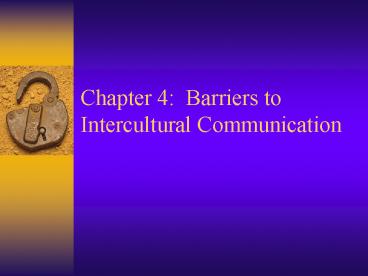Chapter 4: Barriers to Intercultural Communication PowerPoint PPT Presentation
1 / 13
Title: Chapter 4: Barriers to Intercultural Communication
1
Chapter 4 Barriers to Intercultural
Communication
2
This is the first of three chapters meant to help
you recognize and avoid intercultural
communication breakdowns.
3
Focus on Theory
- Berger and Calabrese (1975) uncertainty reduction
theory assumes that our primary communication
goal during the initial phase of interaction is
reduce uncertainty - Gudykunst applied this theory to intercultural
communication by developing the concept of the
strangerpeople in other groups who act in ways
different from ones own culture
4
Six Barriers (stumbling blocks) to Intercultural
Communication (Barna, 1997)
- Anxiety
- Assuming similarity
- Ethnocentrism
- Stereotypes Prejudice
- Nonverbal misinterpretations
- Language
5
Anxiety
- Feeling nervous
- Focus on nervous feeling rather than totally
present in the communication interaction - Example worry that other people may speak too
fast or use words you dont understand - Find yourself making mistakes or saying awkward
things - Affect your ability to communicate your ideas to
others
6
Assuming Similarity
- When you dont have any information about a
culture, its natural to assume there are no
differences - Each culture is different and unique to some
degree - For example, cultural differences in showing
emotions - Assuming difference instead of similarity can
lead to not recognizing important things that
cultures share in common
7
Ethnocentrism
- Negatively judging aspects of another culture by
the standards of ones own culture - To be ethnocentric is to believe in the
superiority of ones own culture - Cultural Relativism means that we must try to
understand other peoples behavior in the context
of their culture before we judge it - We recognize the arbitrary nature of own cultural
behaviors - Cultural nearsightedness Take ones own culture
for granted and neglecting other cultures - Example Use of the term Americans to refer to
U.S. citizens
8
Ethnocentrism (contd)
- Cultural nearsightedness results in making
assumptions that simple things are the same
everywhere - Example Taking husbands last name when married
- Eurocentric ethnocentrism
- Example Basing curriculum only on Western
history, music and art - Far East and Near East from Europe
9
Stereotypes
- First used in 1922 to describe judgments made
about others on the basis of ethnic group
membership - Today more broadly refers to judgments made on
the basis of any group membership
10
Stereotypes
- Is cultural sensitivity stereotyping?
- Is racial profiling stereotyping?
11
Stereotypes
- Negative effects on communication
- Cause us to assume they are true.
- Continued use reinforces the belief (Arabs
wealthy, barbaric, sex maniacs, terrorists. - Impede communication
- Self fulfilling prophecy
12
Prejudice
- The irrational dislike, suspicion, or hatred of a
particular group, race, religion, or sexual
orientation (Rothenberg, 1992) - Examples
- The Roma
- Koreans in Japan
- Irish-Americans
13
Case Study of Barriers to Intercultural
Communication U.S. and China
- The status of Taiwan
- Tibet
- Human Rights and Free Speech
- Broadcast Media and the Internet
- Energy Sustainability
- Economic issues currency undervaluation U.S.
debt.

